Abstract
An eight-week feeding trial was conducted to evaluate the influence of dietary arachidonic acid (20:4n-6) on growth performance, fatty acid composition and antioxidant capacity on postlarva mud crab (Scylla paramamosain). Five isonitrogenous and isoenergetic diets with 0.34% (the control diet), 0.48%, 0.84%, 1.18% and 1.81% ARA levels were formulated by adding ARA rich oil in the basal diet. There were triplicate groups of 28 postlarval crabs (initial weight 8.15 mg) for each diet treatment. The results indicated that crabs fed diets with 1.18% ARA showed significantly higher final body weight (FBW), weight gain (WG) as well as specific growth rate (SGR) than the other groups. Survival, molting frequency (MF) and intermoult period were not significantly affected by different dietary ARA addition. Compared with the stable DHA content in crab, the EPA content decreased significantly with increase of dietary ARA addition. In crabs, superoxide dismutase (SOD) and total antioxidant capacity (T-AOC) activities generally increased with dietary ARA supplementation, and were highest in 1.18% dietary ARA group. The MDA (malondialdehyde) concentrations showed the opposite trend. In addition, with the increase of dietary ARA content, the relatively increased lipid content in body composition was observed. The gene expression of fatty acid synthase (fas) and fatty acid binding protein-3 (fabp-3) in crabs increased with increasing ARA level in diets (0.34–1.18%) and then down-regulated expression levels with further ARA addition (1.81%). These results suggested that moderate dietary ARA level (1.18%) contributed to the improvement of growth performance and antioxidant capacity, and regulated the fatty acid composition and gene expression of some lipid metabolism in crabs, while excessive ARA addition in diets may cause oxidative stress of postlarval Scylla paramamosain. Moreover, the dietary ARA/EPA ratio of 1.82 may be suitable for the growth of postlarval Scylla paramamosain.
1. Introduction
LC-PUFAs, long-chain polyunsaturated fatty acids, are essential fatty acids for the growth and development of farmed animals, especially for marine animals. They are generally defined as PUFAs with ≥ 20 carbon chain length and ≥ 3 double bonds, widely known as docosahexaenoic acid (DHA), eicosapentaenoic acid (EPA) and arachidonic acid (ARA) (Ling et al., 2018). There have been many studies on the physiological functions of DHA and EPA in marine animals (Ibeasa et al., 1994, Sui et al., 2007, Zuo et al., 2012; Calder, 2015; Araújo et al., 2019a; Wang et al., 2021), however, the importance of ARA has been neglected, especially in crustacean. ARA plays an important physiological role in regulating membrane-related enzyme activities, signaling pathways, maintaining the cell physical stability by modifying the fatty acid structure of cell membrane and altering the production of lipid mediators, which subsequently affecting the immune response (Waagbø, 2006; Calder, 2009; Torrecillas et al., 2017; Ma et al., 2018; Miao et al., 2022). Although the literature has proved its importance, there are few studies regarding the dietary ARA effects of crustaceans, including spawning performance, egg quality and stress response with Litopenaeus vannamei (Aguilar et al., 2011), growth performance and immune response of the Macrobrachium nipponense (Ding et al., 2018). A recent study on Eriocheir sinensis also indicated that moderate dietary ARA enhanced some effectors of the immune system (Miao et al., 2022).
It is well known that both ARA and EPA are precursors of eicosanoids, and they compete for the combination with enzymes in the synthesis of eicosanoids, mainly including cyclooxygenase (COX) and lipoxygenase (ALOX) (Araújo et al., 2020). Effects of different eicosanoids (such as prostaglandins (PGs), thromboxanes, leukotrienes (LTs) etc.) are quite diverse in animals, including reproduction modulation, hormone release, inflammatory response and immune function etc. (Rowley et al., 1995, Tocher, 2003, Bransden et al., 2004, Wimuttisuk et al., 2013). Eicosanoids produced by ARA and EPA act differently (Schmitz and Ecker, 2008), especially in regulating the intensity and duration of inflammatory reaction (Lewis et al., 1990, Tilley et al., 2001). Therefore, the level of ARA in the diet and its ratio to EPA may affect the immune response of aquatic animals, and correlative research has not been reported in crabs. Moreover, the deficient or excess of ARA in the diet and/or inappropriate ratios between these LC-PUFAs in diets would inhibit the growth performance of aquatic animals and even cause antioxidant responses (Luo et al., 2012, Kertaoui et al., 2021). Therefore, the determination of dietary ARA levels requires careful evaluation.
Mud crabs (Scylla spp.) are a group of economically important Portunid species that naturally distributed throughout the Indo-Pacific coast (Lin et al., 2018; Ye et al., 2011). Because of its high market demand, mud crabs have been widely cultivated in many Asian countries, especially in China (Zheng et al., 2018). According to China Fishery Statistical Yearbook, the production of mud crabs in 2020 (Scylla paramamosain accounted for more than 90%) reached up to 159, 433 tons (China Fishery Statistical Yearbook, 2021). Up to now, several studies have been carried out to determine the nutritional requirements for Scylla paramamosain (Zhao et al., 2015, Zhao et al., 2016, Zheng et al., 2018, Zheng et al., 2020, Xu et al., 2018, Xu et al., 2020, Zhan et al., 2020, Wang et al., 2020, Wang et al., 2021, Li et al., 2021, Liu et al., 2021). However, no studies have estimated the ARA nutritional requirements of Scylla paramamosain. Moreover, oxidative risk is particularly prone to occur during postlarval stage due to the high metabolic rate of postlarval mud crabs and complex environment challenges they face (Dong et al., 2009, Xu et al., 2018, Xu et al., 2020, Kertaoui et al., 2021). Aguilar et al. (2011) indicated that ARA addition in diets could partly reduce stress response and enhance the immune system of Litopenaeus vannamei. Thus, the present experiment was designed to determine the effects of dietary ARA concentration on growth performance, fatty acid composition, antioxidant capacity and lipid metabolism-related gene expression of postlarval mud crabs.
2. Materials and methods
2.1. Diet preparation
Five isonitrogenous and isoenergetic diets were formulated in this trail. The ingredients and proximate composition were presented in Table 1. Fish meal and casein were used as protein sources, gelatinized starch was used a sole carbohydrate source. Different content of ARA (0.34%, 0.48%, 0.84%, 1.18% and 1.81%) was added into the diets to produce five experimental diets. Fatty acids of the experimental diets were expressed by different fatty acid proportions in total fatty acids (Table 2). Prior to diets preparation, dry diet ingredients were pulverized by the vertical ultrafine pulverizer and grounded through a 125 µm mesh, then thoroughly mixed. Subsequently, different lipid emulsions and phospholipid were added to the mixture, which was then mixed again with distilled water. The mixed dough was further cut into uniform size pellets by the feed granulating machine (with 0.8 mm orifice). Finally, all pelleted diets were dried at 45 ℃ in a constant temperature until the moisture less than 10%. Dried diets were then stored at − 20 ℃ until use.

a Purchased from Trident Seafoods Corporation, Seattle, USA. The protein and lipid content of fish meal are 67.97% and 10.19%, respectively.
b Purchased from Fonterra Co-operative Group Ltd, Auckland, New Zealand.
c Purchased from Zhengzhou Siwei Company, Zhengzhou, China.
d Vitamin premix, g/kg mixture: thiamine B1, 5.0; riboflavin, 8.0; nicotinamide, 26.0; biotin, 1.0; calcium pantothenate, 15.0; vitamin B6, 3.0; folic acid, vitamin B, 5.0; vitamin C, 121.0; vitamin K, 2.02; p-aminobenzoic acid, 3.0; vitamin B12, 1.0; cellulose, 529.0; vitamin A, 25.0; vitamin D3, 25.0; vitamin E, 50.0; inositol, 181.0.
e Mineral premix, g/kg mixture: calcium dihydrogen phosphate, 122.87; lactate, 474.22; sodium dihydrogen phosphate, 42.03; potassium persulphate, 163.83; ferrous sulfate, 10.78; iron citrate, 38.26; magnesium sulfate, 44.19; zinc sulfate, 4.74; manganese sulfate, 0.33; copper sulfate, 0.22; cobalt chloride, 0.43; iodate, 0.02; sodium chloride, 32.33; potassium chloride, 65.75.
f Purchased from Garden Bio-chem Ltd, Zhejiang, China.
g Purchased from Xi’an Wanzi Biotechnology Co., Ltd., Xi’an, China.
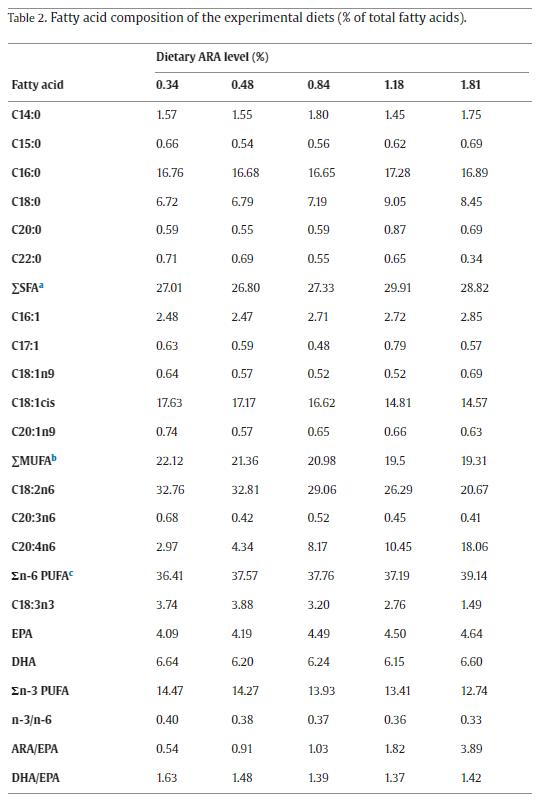
Note. Data are mean of duplicate assays. Only the major fatty acids are shown.
- a
-
ΣSFA is the sum of saturated fatty acids.
- b
-
ΣMUFA is the sum of monounsaturated fatty acids.
- c
-
ΣPUFA is the sum of polyunsaturated fatty acids.
2.2. Crabs and feeding trial
The postlarval mud crabs were obtained from a commercial nursery (Ningbo, China). Prior to the feeding experiment, all crabs were cultured one week for the acclimation. After that, a total of 420 healthy crabs (initial weight 8.15 mg) were randomly selected and put into separate contents (250 ml). The selected crabs were divided into 5 groups with 3 repetitions in each group, and 28 crabs of the same size were selected for each repetition.
The feeding trial lasted for 8 weeks, during the experiment, crabs were fed twice per day (09:00 and 17:00 h respectively). After one hour of each feeding, diets residue, feces and exuviae were sucked out. A complete exchange of water in the container was carried out daily. Death and molting of crabs were recorded every morning throughout the experiment. During the breeding period, salinity and temperature of seawater in the container were maintained at 29 and 26–29 ℃, respectively. Dissolved oxygen remained above 6.0 mg L−1, ammonia nitrogen below 0.05 mg L−1.
2.3. Samples collection
At the end of the eight-week experiment, surviving crabs were fasted for 24 h before being weighed and accounted individually. After that, six crabs per replicate were randomly sampled to evaluate their body composition. Another ten crabs were also selected at random then frozen in liquid nitrogen and subsequently stored at − 80 ℃ for later chemical composition, biochemical parameters and gene expression analysis.
2.4. Chemical analysis
Chemical analysis of diets and crabs were conducted using standard methods (AOAC, Cunniff, 1995). Moisture for crabs were measured to constant weight through lyophilizer (LL1500, Thermo, USA), while for diets was through drying oven. Crude protein and crude lipid were determined using Auto Kjeldahl System (K358/K355, BUCHI, Flawil, Switzerland) and Soxhlet apparatus (E816, Buchi, Flawil, Switzerland) respectively. Extraction of fatty acids was according to Folch et al. (1957). After sample extraction with chloroform/methanol (2/1, v/v), the extract was used for the determination of fatty acid composition after methylation into fatty acid methyl esters (Metcalfe et al., 1966). Fatty acids of samples were measured by a gas chromatograph (GC7890B, Agilent Technologies Inc., CA, USA). The specific parameter settings of the gas chromatograph are consistent with Liu et al. (2021).
Whole crab supernatants were prepared according to the method described by Xu et al. (2018) for assay of antioxidant parameter. For superoxide dismutase (SOD), xanthine oxidase method was used to determine the activity (Peskin and Winterbourn, 2000). Total antioxidant capacity (T-AOC) was determined by ferric reducing ability of plasma (FRAP) method (Benzie and Strain, 1996). Malondialdehyde (MDA) levels in crabs were determined by measuring thiobarbituric acid (TBA) reactive substances (Ohkawa et al., 1979). Total protein concentration in crabs was determined with Coomassie Brilliant Blue method (Bradford, 1976). All biochemical parameters of crabs were determined using commercial kits (Jiancheng, Ltd, Nanjing, China) and microplate reader (iMark, Bio‐Rad, Hercules, USA).
2.5. Gene expression
According to Chomczynski and Sacchi (2006), total RNA of the whole crab was extracted using Trizol® Reagent (Invitrogen, Carlsbad, CA, USA), chloroform, isopropanol, ethanol, and diethylpyrocarbonate (DEPC) water and its quality was ananlyzed in 1.0% agarose electrophoresis. The cDNA was synthesized from 1 μg treated RNA using PrimeScript™ RT Reagent Kit (perfect Real Time) (Takara, Dalian, China) through the manufacturer’s instructions. Quantitative real-time PCR was conducted to evaluate the relative mRNA expression level of elongation of fatty acid binding protein-3 (fabp-3) and fatty acid synthase (fas) by the Applie Biosystems QuantStudio™ 6 Flex Real-Time PCR System (Life Technologies, Carlsbad, USA). The primers used in test genes presented in Table 3 (manufactured by Sangon Biotech Co., Ltd, Shanghai, China). The conditions of quantitative real-time PCR were consistent with the description of Liu et al. (2021). β-actin gene was used as an internal control in this experiment (Gong et al., 2015). Meanwhile, each sample was run three times during the detection. The relative expression levels of objective genes were calculated by the equation of comparative CT method (Livak and Schmittgen, 2001).

2.6. Statistical methods
In the first step of analysis, all data were checked for normal distribution and homogeneity through Kolmogorov Smirnov test and Levene’s test. Then the homogenous and heterogeneous variance data were analyzed by ANOVA and nonparametric Kruskal-Wallis, respectively. In this study, results were showed by mean ± SD. Statistically different data were analyzed by Duncan’s multiple-range test and P < 0.05 represented a significant difference. All statistical analysis of the data was performed on SPSS 22.0 software.
3. Result
3.1. Survival, growth performance
The survival, specific growth rate (SGR), weight gain (WG), molting frequency (MF) and intermoult period are shown in Table 4. The survival of Scylla paramamosain ranged from 63.10% to 82.14% (P > 0.05). Dietary ARA levels significantly influenced the growth performance of the postlarval Scylla paramamosain (P < 0.05). The FBW, WG, and SGR of crabs significantly increased with dietary ARA level up to 1.18% and then significantly decreased with dietary ARA level further increased. In addition, there was no significant difference in MF and intermoult period in different treatments (P > 0.05).
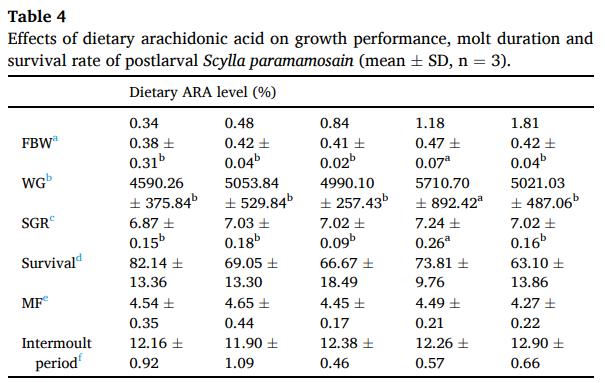
Notes. Different superscript letters in the same row indicate significant differences (P < 0.05) among different treatments.
- a
-
FBW (g): final body weight.
- b
-
WG: weight gain (%) = 100 × (final weight – initial weight)/initial body weight.
- c
-
SGR (% per day): specific growth rate = 100 × (ln final weight – ln initial weight)/days.
- d
-
Survival (%) = 100 × (final amount of crabs) / (initial amount of crabs).
- e
-
MF: molting frequency = (∑molting times of every survival crab)/final amount of crabs.
- f
-
Intermoult period (day) = days/molting frequency
3.2. Whole body composition
In present study, though there was no significant difference in body composition of the whole crab among all treatments (P > 0.05) (Table 5), crude lipid showed a relatively increased trend with the increase of dietary ARA supplementation. As shown in Table 6, ARA concentrations in body increased with the dietary ARA addition in this experiment. Compared with the relatively stable composition of DHA in crabs, the EPA contents in crabs decreased with increasing dietary ARA levels (P < 0.05).
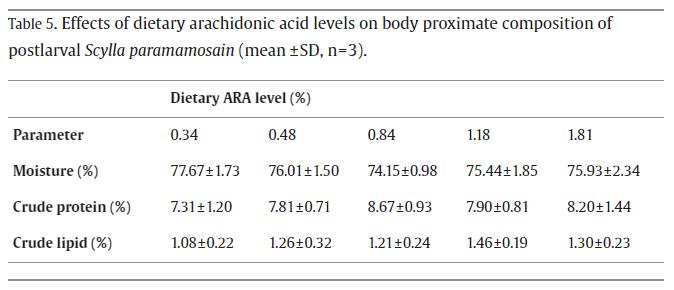
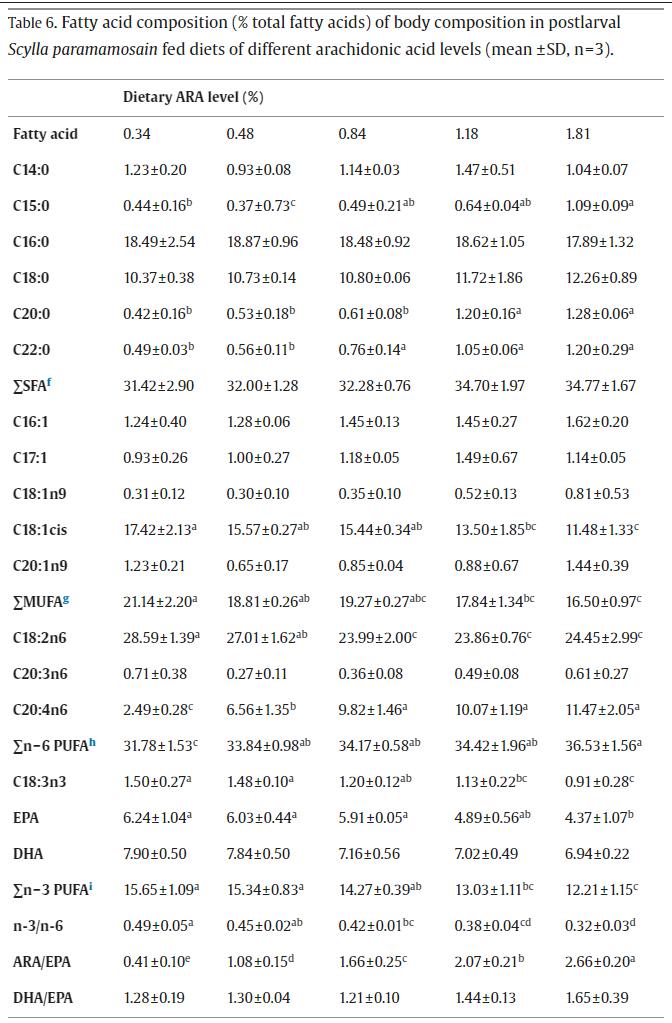
Note. Data with different letters significantly differ (P < 0.05) among treatments.
- f
-
Σ SFA is the sum of saturated fatty acids.
- g
-
Σ MUFA is the sum of monounsaturated fatty acids.
- h
-
Σn-6 PUFA is the sum of n-6 polyunsaturated fatty acids.
- i
-
Σn-3 PUFA is the sum of n-3 polyunsaturated fatty acids.
3.3. Antioxidant parameters
In this experiment, dietary ARA levels significantly affected the MDA concentration, SOD and T-AOC activity of postlarval mud crabs (P < 0.05). The activity of SOD significantly increased as dietary ARA increased from 0.34% to 1.18% and decreased slightly at higher ARA concentrations (Table 7). The T-AOC activity in the crabs was the same as SOD. In contrast, MDA activity was generally positively correlated with ARA supplemental level, and crab fed the diet with 1.81% ARA showed the highest MDA activity.
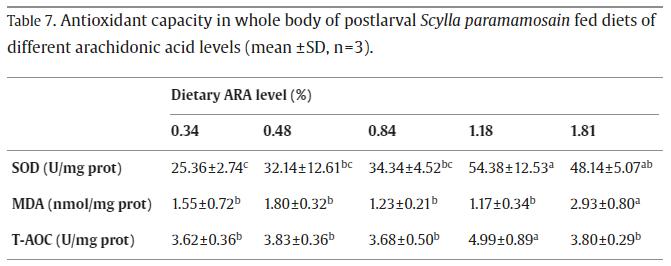
Note. Values with different superscripts in the same column are significantly different (P < 0.05).
3.4. Gene expression
The mRNA expression of fas was significantly affected due to different dietary ARA addition. As shown in Fig. 1, the mRNA expression of fas in crabs increased with increasing dietary ARA from 0.34% to 1.18% and reached the highest value in 1.18%, and then significantly decreased with dietary ARA supplement further increasing to 1.81% (P < 0.05). Meanwhile, although the mRNA expression of fabp-3 showed no significant difference among dietary ARA treatments, there was a similar trend of change with fas. The mRNA expression of fabp-3 generally increased first with the addition of dietary ARA (0.34–1.18%) and then decreased with further dietary ARA addition.

Fig. 1. Lipid metabolism-related gene expressions in whole crab of pastlarval Scylla paramamosain with different arachidonic acid levels measured by real-time quantitative PCR. Data (mean ± SD, n = 3) with different letters significantly differ among treatments (P < 0.05).
4. Discussion
Previous studies have demonstrated the important role of ARA in regulating growth performance and immune response in Sparus aurata L., Lateolabrax japonicus, Synechogobius hasta, Anguilla japonica, Pelteobagrus fulvidraco, etc. (Fountoulaki et al., 2003, Tocher, 2003, Bae et al., 2010, Xu et al., 2010, Luo et al., 2012, Ma et al., 2018, Magalhães et al., 2019). In general, appropriate amount of dietary ARA could promote growth performance of some aquatic animals, while excess dietary ARA might cause growth inhibition and oxidative stress (Adam et al., 2017, Ding et al., 2018, Miao et al., 2022). In the present study, the WG and SGR of postlarva Scylla paramamosain were significantly enhanced when the ARA level in the diet was increased to 1.18%, and then a decline of growth was observed with further dietary ARA addition. Similar results were also found in some other species, such as 0.92% ARA for Anguilla japonica (Shahkar et al., 2016), 1% ARA for adult Strongylocentrotus intermedius (Zuo et al., 2018), 0.5–1.9% ARA for juvenile Rachycentron canadum (Araújo et al., 2019b) and 1.25% ARA for larval Dicentrarchus labrax (Atalah et al., 2011). However, Torrecillas et al. (2017) found that increasing dietary ARA levels by 0.2–1.4% did not enhance growth of juvenile Dicentrarchus labrax. The differences in various studies may be due to species-specific responses or different growth stages (Shahkar et al., 2016). Numerous studies have found that the survival rates of some marine organisms were not significantly affected by various dietary ARA treatments, such as juvenile Japanese seabass (Xu et al., 2010), juvenile Trachinotus ovatus (Qi et al., 2016), juvenile Macrobrachium nipponense (Ding et al., 2018) and Lutjanus malabaricus fingerlings (Chee et al., 2019). While some studies have shown that dietary ARA can enhance the survival of marine animals (Bessonart et al., 1999, Koven et al., 2001). In this experiment, no significant difference in survival was found among different ARA treatments. Similarly, there were no significant differences in molt frequency (MF) (4.27–4.65) and molt period (11.90–12.90) between dietary treatments in the trial. In crustaceans, molting is directly regulated by ecdysteroids released into the hemolymph (Subramoniam, 2000). Zhang et al. (2013) also found that not ARA but DHA could regulate the molting of juvenile crab by regulating the metabolism of ecdysteroids.
Previous studies have reported that the composition of dietary fatty acids generally affect the body fatty acids of aquatic animals (Fountoulaki et al., 2003, Nasopoulou and Zabetakis, 2012). Consistent with these studies, ARA concentrations in crab body increased with the ARA addition in diets in this experiment, similar results have been reported in other species (Luo et al., 2012, Tian et al., 2014, Torrecillas et al., 2017). However, the concentration of EPA and DHA in whole body showed higher values than in diets. Interestingly, the EPA contents in tissues decreased with increasing dietary ARA levels. Similar results were found in other aquatic animals, such as Anguilla japonica (Shahkar et al., 2016), Sparus aurata L. (Fountoulaki et al., 2003), Ctenopharyngodon idellus (Tian et al., 2014) and Cynoglossus semilaevis (Yuan et al., 2015). Compared with the decrease of EPA content in body composition, DHA content remained relatively high and stable with the increase of ARA level in whole body, similar result was reported in Synechogobius hasta (Luo et al., 2012). In general, as a functional fatty acid, DHA has a more important function than EPA in larvae (Watanabe et al., 1989, Takeuchi et al., 1990, Toyota et al., 1991, Koven et al., 1993, Wu et al., 2002). Therefore, these results showed that DHA was selectively retained compared with EPA, as has been reported in some other marine species (Izquierdo, 1996, Carvalho et al., 2018, Wang et al., 2021). In contrast, EPA is a preferred substrate for mitochondrial β-oxidation compared to DHA and ARA (Froyland et al., 1997, Madsen et al., 1999, Xiao et al., 2022). Furthermore, direct competition between ARA and EPA in different pathways, including phospholipid incorporation, results in a decrease in EPA concentration in the body (Calder, 2015, Johnson et al., 2021). In addition, the reductions in EPA content subsequently led to the changes in the ratio between DHA and EPA in the body. It is well known that a suitable DHA/EPA ratio is required to optimize growth performance in aquatic animals (Izquierdo et al., 2000), and an inappropriate DHA/EPA ratio in diets has been shown to reduce crustacean growth (Copeman et al., 2002). In this experiment, the DHA/EPA ratio of the best growth dietary treatment group was 1.37, which should be suitable for the growth of postlarval Scylla paramamosain. Correspondingly, optimum DHA/EPA ratio in diets was around 1.20 for gilthead sea bream (Rodríguez et al., 1997, Rodríguez et al., 1998).
On the other hand, ARA can effectively improve the stress response of postlarvae, possibly due to its physiological function as the precursor of eicosanoids (Willey et al., 2003). Both EPA and ARA are known to be precursors of eicosanoids, a class of highly active molecules that participate in various stress responses (Sargent et al., 1995, Fountoulaki et al., 2003). However, different series of eicosanoids derived from EPA and ARA respectively have different physiological functions (Tian et al., 2017, Araujo et al., 2021). As one of the major eicosanoid groups, PGs play critical role in ion transport, signaling pathways and release of intracellular Ca2+, regulating several immune functions (Rowley et al., 2005). Some researchers have deduced that ARA can regulate growth by changing the ratios between different prostaglandins (PFE2 and PGF2a) (Xu et al., 2010), which are involved in muscle fiber formation and protein degradation (Palmer, 1990, Bell and Sargent, 2003), while PGE3 (derived from EPA) is generally less biologically active than the PGE2 (derived from ARA) (Tocher, 2003). Boglino et al. (2014) also mentioned the relative ratio of the two prostaglandins (PGE2 and PGE3 series) is influenced by the imbalance ratio of ARA/EPA in diets. Normally, ARA/EPA ratio is used as a better method of expressing ARA requirement than the dietary “ARA requirement”. Previous study also showed that dietary ARA and EPA levels must reach a suitable balance to optimize growth (Norambuena et al., 2016). In the experiment, the dietary ARA/EPA increased with dietary ARA increasing. At the end of the experiment, postlarval Scylla paramamosain fed the dietary ARA1.18 with the ARA/EPA ratio (1.82) showed significant higher WG and SGR than other treatments. The result suggested the ARA/EPA ratio at 1.82 might be suitable for postlarval Scylla paramamosain to achieve good growth. Similarly, in Anguilla japonica, the better growth performance occurred in the 1.06% dietary ARA group with an ARA/EPA ratio of 1.80 (Shahkar et al., 2016). In fact, the optimal dietary ARA/EPA ratio for different aquatic animals may be specific. Recommended dietary ARA/EPA ratios vary among species, such as 1.78–2.95 for yellow catfish (Ma et al., 2018), 0.33–1.02 for Japanese seabass (Xu et al., 2010) and 0.32 for European sea bass (Atalah et al., 2011). Overall, an optimum ratio between ARA, EPA and DHA seems to be necessary to improve the growth performance of postlarval Scylla paramamosain.
The results of the present experiment showed that crude lipid content of Scylla paramamosain generally increased when dietary ARA levels increased from 0.34% to 1.18%, then decreased with further dietary ARA addition. Similar results were found in Trachinotus ovatus and Synechogobius hasta that moderate ARA level could promote adipogenesis and affect lipid metabolism (Qi et al., 2016, Luo et al., 2012). FAS is considered as an important multi-functional enzyme related to lipid metabolism (Smith et al., 2003). In the research, the gene expression levels of fas generally increased with dietary ARA levels (0.34–1.18%), then dramatically reduced with higher level of dietary ARA (1.81%). Similar results were observed in Pelteobagrus fulvidraco (Ma et al., 2018). FABPs are a family of proteins with high affinity for fatty acids and play an important role in the absorption and transport of fatty acids (Tipping and Ketterer, 1981, Bernlohr et al., 1997, Glatz et al., 1995). In this study, although the fabp-3 gene expression levels showed no significant differences among treatments, there was a similar trend of change with fas. In agreement, Xu et al. (2017) also suggested that moderate dietary ARA levels could enhance the gene expressions of fabps in different tissues. Therefore, these results suggest that appropriate dietary ARA can affect lipid accumulation, while excessive dietary ARA may cause an imbalance in lipid metabolism.
In this experiment, both SOD and T-AOC activities increased with dietary ARA addition from 0.34% to 1.18% and then decreased, and crabs fed diets with 1.18% ARA showed highest SOD and T-AOC activities than other groups. Correspondingly, Miao et al. (2022) also indicated moderate dietary ARA addition could increase serum SOD activity in Eriocheir sinensis. Similar results were found in Lateolabrax japonicus (Xu et al., 2010) and Lutjanus malabaricus (Chee et al., 2019). As a potent indicator to identify the degree of oxidative damage, a higher level of MDA indicates that the body may face certain oxidative damage (Draper and Hadley, 1990). In this experiment, the MDA concentrations generally decreased first with the addition of dietary ARA (0.34–1.18%) and then increased, and 1.81% dietary ARA treatment showed significantly higher MDA concentration than other treatments (P < 0.05). Similar results were observed in Eriocheir sinensis (Miao et al., 2022). The result may indicate that the appropriate dietary ARA level can effectively improve the antioxidant capacity of postlarval Scylla paramamosain, while excessive ARA in diets may result in a higher risk of lipid peroxidation.
In conclusion, the results of this study suggested that the appropriate dietary ARA level (1.18%) can significantly improve the growth performance and antioxidant capacity in Scylla paramamosain. However, excessive ARA supplementation in the diet may lead to oxidative stress in postlarval Scylla paramamosain. Meanwhile, the content of EPA in crab decreased with the increase of dietary ARA level, while the content of DHA in crab was relatively stable.
By Pan Bian, Hanying Xu, Xinzhi Weng, Teng Liu, Tao Liu, Tao Han, Jiteng Wang, Chunlin Wang
Reference: https://www.sciencedirect.com/science/article/pii/S2352513422002228
“Domesticated Shrimp Postlarvae – The Key To Success”
See more:
- Effect of HUFA-enriched artemia on the performance of Pacific white shrimp postlarvae
- Effect of a microencapsulated probiotic on the intestinal microbiome of Pacific white shrimp
- Robins McIntosh on everything you need to know about EHP and shrimp farming, part 1

 Tiếng Việt
Tiếng Việt 中文 (中国)
中文 (中国)